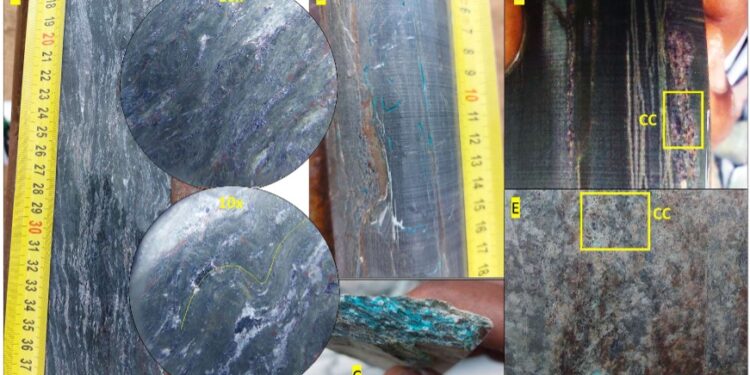Cobre Limited (ASX: CBE) has intersected significant copper mineralisation, containing both grade and width from ongoing infill drilling underway at the Comet Target within the Ngami Copper Project (NCP) in the Kalahari Copper Belt (KCB), Botswana.
Hole NCP20A has intersected a significant 45m zone of chalcocite mineralisation within a parasitic fold which appears to have acted as a trap-site, effectively upgrading the grade and thickness of copper mineralisation which is characteristic of known KCB deposits.
“Since our initial discovery at the NCP, we have moved rapidly to drill out the potential of this new copper district,” Executive Chairman and Managing Director, Martin Holland, said.
“Cobre is delighted with the latest copper discovery intersection which has both the thickness and grade to move the economics on the Comet Target. Importantly, these results provide further evidence for the team’s current exploration model by demonstrating that high-grade zones of mineralisation occur along this extensive target.
“This discovery hole is a significant step forward in the company’s journey to unlocking a copper deposit in the KCB, and we look very forward to providing updates on our ongoing drilling programme as we advance this exciting new copper district.”
Mr Holland said mineralisation increases significantly with depth through the intersection, with the lower portion reporting visual estimates of chalcocite in excess of 10% (confirmed and supported by pXRF measurements).
NCP20A is part of an ongoing infill drilling programme targeting structurally controlled high-grade mineralisation within the Comet Target at NCP which is defined by its extensive >4km footprint of anomalous chalcocite mineralisation. The significant results from NCP20A demonstrates the efficacy of the current targeting model, and provides further evidence that the copper-silver (Cu-Ag) mineralisation within Comet comprises a high-grade structurally controlled component which significantly upgrades the economic potential of the target.
NCP20A Results
The current drill programme at NCP has been designed to intersect sediment-hosted, structurally controlled Cu-Ag mineralisation associated with the redox contact between oxidised Ngwako Pan Formation red beds and overlying reduced marine sedimentary rocks of the D’Kar Formation on the steeply dipping northern limb of an anticline structure. Drilling to date has focussed on the Comet Target which is defined by anomalous chalcocite intersections along a footprint of more than 4km, typical of other known deposits in the KCB. Within the anomalous chalcocite halo at Comet, drilling has returned several significant intersections of Cu-Ag mineralisation, most notably at NCP08 (10.7m @ 1.3% Cu and 18 g/t Ag).
NCP20A is located 250m southwest of NCP08, forming part of an infill drill programme designed to test for structurally controlled trap-sites, such as parasitic fold structures where higher-grade mineralisation may occur within the Comet Target.
The drill hole has intersected 80m of Kalahari Group cover underlain by a series of coarsening upward sedimentary cycles of the lower D’Kar Formation. Significant mineralisation is hosted in the lowermost cycle which extends to the Ngwako Pan Formation contact at 155.3m downhole. Importantly, the lower D’Kar Formation siltstones and marl unit are folded above the contact providing an ideal fluid trap-site, as well as a thickening of mineralised siltstones.
Visual mineralisation consists primarily of chalcocite, with subordinate chrysocolla, and increases significantly towards the basal marl unit where visual estimates of more than 10% chalcocite has been confirmed with both 25cm spot and grove sampling pXRF measurements.
Provisional infill drilling results have identified compelling targets for higher-grade mineralisation controlled by parasitic folding of lower D’Kar Formation stratigraphy. These folds typically plunge obliquely to the primary anticlinal structure and will likely repeat along the length of the Comet Target, providing elongated zones of higher-grade mineralisation.
Previous work at Khoemacau’s Zone 5 deposit in the northern part of the KCB also flagged the value in mapping lead (Pb) anomalies as a potential vector to identifying up-dip fluid flow from deeper high-grade parasitic folds. The prevalence of Pb anomalies in several holes at Comet may thus be indicative of additional deeper high-grade zones, opening the potential strike length of this exciting discovery.
For further information please visit: https://www.cobre.com.au/












